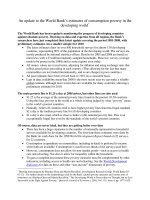Warfare in the medieval world (history of warfare)
Bạn đang xem bản rút gọn của tài liệu. Xem và tải ngay bản đầy đủ của tài liệu tại đây (11.71 MB, 88 trang )
ra*$«
wk
ARFARE
in the
Medieval
World
Chris Marshall
ston Public Library
5^ARFARE
Medieval World
(
HISTORY OF WARFARE
Chris Marshall
,,RAINTREE
^T
STECKVAUGHN
PUBLISHERS
A Steck-Vaughn Company
Steck-Vaughn Company
First
published 1999 by Raintree Steck-Vaughn Publishers,
an imprint of Steck- Vaughn Company.
Copyright
No
All rights reserved.
part
©
1999 Brown Partworks Limited.
of this book may be used or reproduced
in
any manner whatsoever or transmitted
any form or by any means, electronic or mechanical, including photocopying, recording, or any information
storage and retrieval system, without written permission from the copyright owner except in the case of brief
in
quotations embodied
in critical articles
P.O.
and reviews. For information, address the publisher: Steck-Vaughn,
Box 26015, Austin, TX 78755.
Library of Congress Cataloging-in-Publication Data
1962-
Marshall, Chris,
Warfare
the Medieval world
in
/
Chris Marshall,
— (History of warfare)
cm.
p.
Includes bibliographical references and index.
Summary: Provides an overview of the evolution of military
conflicts
from the
fifth
through the
fifteenth centuries, describing
make-up of the armies,
ISBN 0-8172-5443-9
changes
the
in
— History — Juvenile
— Juvenile
Military
Military
and science — History.]
Tide.
Military art and science
1.
2. Military history,
literature.
Medieval
history, Medieval.
II.
fighting tactics, and weapons.
2.
literature.
[
1.
art
I.
History of Warfare (Austin, Tex.)
Series;
U37.M37
1999
— dc21
355\009'02
98-11957
CIP
AC
Printed and
1
bound
2 3 4 5 6 7 8 9
in the
United States
IP 03 02 01 00 99 98
SB BR
J
U37
.M37
1999
Managing
r.cnror: lan Vvcstwcll
Senior Designer: Paul Griffin
Picture Researcher:
Editorial Assistant:
Wendy
Verren
|.
Antony Shaw
Cartographers: William
Index: Pat Coward
le
Bihan, John See
R a in tree
Consultant
Steck - Va nghn
Publishing Director: Walter Kossmann
Project Manager: Joyce Spicer
Dr. Niall Barr, Senior Lecturer,
Editor: Shirlev Shalit
Camberlcy, Surrey, England
Acknowledgments
NOV
Front cover: The Burgundian attack on the town of
Grandson, Switzerland, in 1476 (main picture) and
the Norman leader Robert Guiscard (inset
Page 1: The Crusaders reach Jerusalem, 1099.
listed
on page 80 constitute
1 4 1998
SOUTH BOSTON BRANCH
Royal Military
Academy Sandhurst,
part of this copyright page.
Contents
Introduction
4
The
Early Byzantine Empire
5
The
Islamic
Empire
14
The Carolingian Empire
16
The Viking Menace
22
The Norman Conquests
26
The Crusades: Wars of Religion
32
Medieval Siege Warfare
42
The Mongol
48
Invasions
The Hundred
The
Years
Rise of the
The New
War
Ottomans
Professional Armies
52
64
70
Conflict in the Far East
76
Glossary and Bibliography
78
Index
79
Acknowledgments
80
Introduction
volume looks at the history of war
between the 5th and late 15th centuries. For most of this period both wars
and campaigns were decided by a single,
Commanders
This
decisive battle.
Most
countries did not have
the wealth to support a large permanent
army
in
to follow
—
war for a set period three
months, for example and were then free
to head for home.
The core of a medieval army was made
up of mounted warriors, chiefly lance -armed
armored knights. Although few in number,
knights and their personal followers, known
as men-at-arms, were the dominant force on
their ruler to
—
the battlefield.
A
single
thunderous charge
often decided a battle. Knights were highly
weapons than the
humble infantrymen who made up the bulk
and
carried better
However,
as the
medieval period drew
to a close the foot soldier began to over-
the
cavalryman
in
importance.
Archers, particularly those armed with the
longbow, had the hitting power to stop a
its tracks, while pikemen
with their long spears proved they could
take on and defeat cavalry in hand-to-hand
combat. Infantrymen were especially successful against knights, if they fought
behind defenses such as ditches.
Toward the end of the period gunpowder weapons primitive firearms and
cannon were also being used in battles
and sieges, and the first professional standing armies were being formed.
cavalry charge in
—
in
position
rulers or nobles,
the
medieval
because
not because they were
the modern
Most were competent, although
generals
world
they were
in
sense.
a
few
were outstanding.
Many commanders saw
seeking out the
ble
enemy
their
job as
as quickly as possi-
and then leading by example, fighting
bravely in the front rank.
began, they often had
little
Once
a battle
impact on
its
development. At the end of the medieval
era commanders were beginning to stand
back from the confused fighting. From
this vantage point they could direct their
forces with greater control.
Castles and fortified towns played an
important role in medieval warfare until
the arrival of cannon. Castles were used to
protect a vulnerable area from attack, to
control a rebellious region, or were a base
of any army.
take
their
trained
times of peace or fight long wars.
Most noblemen were obliged
trained
held
—
from which an army could launch an
offensive. Sieges were time-consuming
and costly, and more castles fell to treachery, disease, and hunger than assault. The
introduction of cannon, however, sounded
the death knell of castles because artillery
could smash stone walls with ease.
War in the medieval world was neither
stagnant nor unchanging. New weapons
were introduced, and armies became
increasingly professional. By the end of the
15th century, war was no longer a contest
solely between nobles but was becoming a
conflict between armies of trained soldiers,
the vast majority drawn from outside the
ranks of the nobility.
The Early
Byzantine Empire
existed but
the second half of the 5th century A.D. the Roman Empire
Inhad
split. The western half was controlled from Italy, while the eastern half
still
was ruled from Constantinople (Istanbul in modern Turkey). Hostile tribes,
called barbarians by the Romans, had broken through the empire's borders.
The barbarians brought the western empire to an end in 476. The eastern
empire was threatened by many enemies, but it survived for 1,000 years.
Historians call this part of the former Roman Empire the Byzantine Empire.
Constantinople was
the heart of the
Byzantine Empire.
From there a
succession of mighty
emperors ruled over
a great kingdom.
Its
capture, after a siege
by the Ottoman Turks
in 1453,
marked the
end of the 1,000-yearold empire.
Warfare
in
the Medieval World
The
Byzantine
Empire
its
name was changed
from
I
(fifth
right) ruled
the Byzantine Empire
from 527
to
and proved
so-called
because
the
of
city
was previously called Byzantium. Its
to honor the Roman emperor
Constantine I. In the late 5th century AD. the empire stretched
from what are now the Balkans in the west, across Turkey, and
into the Middle East. It also included Egypt and parts of Libya.
At the eastern edge of the large empire lay the border with
Byzantium's great rival, Persia.
Constantinople,
Justinian
is
capital,
in
AD. 330
565
to
be
an energetic emperor.
Persian expansion into Byzantium
Conflict between the empire and Persia had been going
on
for
His armies were led
hundreds of years. In 502 the two began
by two of the most
ed on and off for 100 years.
able generals of the
Another was the religious differences between the Christian Byzantines and the non-Christian
Persians. There was also a quarrel over who was to pay for their
joint defense against fierce nomads
the Huns. These deadly
enemies were trying to break into the region from the north.
age, Belisarius
Narses,
and
and
restored
the empire's former
borders.
expansion into Byzantine
One
a series
of wars that
last-
cause of the wars was Persian
territory.
—
The Early Byzantine Empire
Belisarius
The Byzantine
rose to
military
fame through
Emperor
genius Belisarius
his exploits in
Justinian's First Persian
War
down
(524-532). He also helped to put
a serious rebellion against Justinian
in
Constantinople soon afterward.
Belisarius
faithfully
went on
to serve Justinian
throughout his career. The
emperor, though, seems to have been
jealous of his general's success and did
not trust him. Justinian ordered him back
to Constantinople
from North Africa
in
544, so that he could keep a close watch
on him
for signs of treason.
Despite this jealousy Justinian always
turned to Belisarius whenever the going
got tough. In 554 the emperor called
him out of retirement
to take
a Byzantine campaign
in
charge of
southern Spain.
Five years after that, with barbarian
invaders almost at the gates of
Constantinople, Justinian once again
recalled Belisarius.
The general saved the
imperial capital from the invaders. After
these heroics Belisarius returned to
retirement. But Justinian accused
of treason
and put him
in
him
prison in 562.
The following year the emperor decided
that he
had been wrong. Belisarius was
released to
The
First
live
the rest of his
Persian
Emperor
life in
peace.
Belisarius pictured as
an old man
years of successful campaigns
War (524—532) was fought during
Justinian
Belisarius. Belisarius
after
expand
the frontiers of the Byzantine Empire.
the
I. Justinian launched the career of
was one of the most brilliant Byzantine generals. In 530, heavily outnumbered, he defeated the Persians at
the Battle of Dara. He goaded the 40,000-strong Persian army
into assaulting his foot soldiers, \\ horn he put behind trenches. As
reign of
to
—
Warfare
in
the Medieval World
the Persians advanced into the trap, the Byzantine cavalry tanned
out to the
left
and
the cataphracts
right.
Then
— surrounded
the Byzantine armored cavalry
the
launched
Persians,
a
superb
charge, and destroyed them.
Battle against the barbarians
that First Persian War ended, Justinian decided
When
the old western empire from the barbarians.
to lead the campaign. Belisarius struck
He
at
first
ian tribe called the
the 5th century
foot.
A Byzantine
The term cataphract comes from
AD.
landed in what
fleet
Tunisia in September 533.
men poured
is
now
Some 15,000
off the ships and marched
on
the Greek word for "covered"-both the
the ancient city of Carthage, the Vandals''
horse and the rider were covered with
capital.
metal armor.
were near the
This type of heavy cavalry
appeared
They met no
city.
resistance until they
At
commanded by
forces
first
the armies of the Parthian
in
this
point three
the Vandal king,
Gelimcr, attacked the Byzantine invaders
time of the Romans. The
moved into a narrow valley ten
miles (16 km) from Carthage.
The Vandals' timing was poor. Instead
cataphracts and created heavy cavalry
of attacking together at the front, center,
and rear of Belisarius's army, they struck in
three separate waves. Belisarius and his
Empire, which existed
in
Asia during the
Romans fought
many wars against the Parthians. The
Romans were impressed with the
units of their own.
made
The Byzantines
later
the cataphracts the major force
in their
Mounted on powerful warhorses,
carried a bow, a lance, a sword,
and a
dagger. Besides body armor they wore
an
iron
helmet and carried a shield.
The shield was strapped
to the
was "shock
troops were able to deal with each Vandal
The main cataphract
action," a ferocious
that crashed through
Hun
tactic
charge
any enemy.
cavalry,
mounted
warriors
much
astating archery. After this Battle of
Decimum
the
capital.
Ad
marched un-
Byzantines
opposed into the
The defeated
barbarian forces tied into the desert.
The following December though,
arm so
they could use both hands to control
their horses.
they
feared for their lightning attacks and dev-
weapons. They usually
bristled with
as
force in turn. Manx' of his troops were
army.
Byzantine cataphract cavalrymen
Vandals were
back with
a
large
the
army,
including local tribesmen. Belisarius took
army to confront the Vandals at
Tricameron, 30 miles (48 km) from the
his
capital.
8
Africa,
a
had spread across Northern Europe into
Spain and crossed over to North Africa in
Byzantine cataphracts were heavy
cavalry dressed in armor from head to
North
German barbarVandals. The Vandals
which was then ruled by
Cataphract CAVALRY
to regain
chose Belisarius
Immediately Belisarius launched
a
The Early Byzantine Empire
F
U
THE EARLY BYZANTINE EMPIRE
FRANKISH
KINGDOM
V
wRome
0536-5__
Dara
530
Neapolis\W°
X
Antioch
RANEAN SEA
Alexandria^
ARABIA
of cavalry charges against a force that outnumbered his
troops by almost ten-to-one. The Byzantines drove the Vandals
series
Hun
horsemen, mercenaries
whose loyalty to the Byzantine Empire was doubtful, decided
they were on the winning side and charged. The Vandals ran.
At
back.
this
point
Belisarius's
The Byzantine Empire
spread through
thanks
to the
victories
against the Ostrogoths
The Vandal kingdom in North Africa was finished, but it took
until 548 for the Byzantines to complete their conquest of the
local tribes. Justinian recalled Belisarius
almost immediately after
Tricameron and sent him to invade Italy. Italy was ruled by the
Ostrogoths, another barbarian tribe. Belisarius began his campaign by invading the island of Sicily in 535.
He
easily
conquered
the island and then laid siege to the important city of Naples
'then
known
as
Neapolis)
on the
Italian
mainland.
After about three weeks of blockade one of the Byzantine sol-
waterway leading into the city, which
allowed Belisarius to smuggle a force under the city walls. A
simultaneous attack by these troops and the besiegers outside
ended in a complete Byzantine victory. Belisarius's forces, which
diers discovered a disused
contained
many
who
barbarian troops, then
showed what happened
to
them. The Byzantines rampaged through
Naples, burning, looting, and killing at will.
people
resisted
major
of Belisarius
and Narses.
War
much
of the Mediterranean
Warfare
in
the Medieval World
Ostrogoth besiegers
try to
of
storm the walls
Rome
in 537.
Belisarius,
although
outnumbered, was
able to prevent the
city
from being
Rome
was
December 536
Belisarius's
next
target.
He
to find the city undefended.
arrived
there
in
The Ostrogoths had
decided they needed time to build up their forces and had with-
The following March
Rome. They cut off its
water supply and began a blockade. The siege dragged on. The
Ostrogoths could not break in Rome's walls and Belisarius's
drawn to Ravenna,
a port
on the
east coast.
the Ostrogoths returned and surrounded
—
captured. The
catapults and ballistas (arrow-firing catapults) saw to that. But the
Ostrogoths were
Byzantines could not break out. Eventually Byzantine reinforce-
forced to retreat
relief force arrived
ments arrived and the Ostrogoths withdrew in 538.
Belisarius chased the Ostrogoths back to Ravenna and
besieged them. With no other choice the Ostrogoths offered to
the next year.
make
when a Byzantine
10
Belisarius their king if he turned against Constantinople.
The Early Byzantine Empire
When
seemed to agree, the Ostrogoths opened the
Belisarius
Once
though, Belisarius captured the
Ostrogoth leaders and led them back to Constantinople as his
prisoners. Belisarius was not allowed to rest, however. Another
war with Persia had started, .\nd he was needed in the east.
gates of Ravenna.
inside,
Narses in Italy
The Ostrogoths, however, were not finished in Italy. As soon as
Belisarius had left, they broke out of their remaining strongholds
a\u\
took back most of the territory the Byzantines had eaptured.
544 but was not given a big enough army
Belisarius returned in
to regain the lost territory. Justinian had to send another gener-
men. The
was not a trained soldier. He was an official at the
Byzantine court, but he proved to be a great general.
Marching into Italy from the north in 552, Narses quickly
crushed the Ostrogoths at the Battle of Taginae in June. His soldiers killed the Ostrogoth leader, Totila, and more than 6,000
of his troops. Narses then continued south and captured Rome
for the empire once again. The Ostrogoths headed farther south
to Naples. Narses followed and defeated the Ostrogoth army
completely at the Battle of Monte Lacteria (553).
al,
Narses, this time with a force of 20,000 to 35,000
elderly Narses
Narses and the battle of taginae
In
As the 15,000 Ostrogoths came
June 552 the Byzantine army came
face to face with an Ostrogoth force in
a narrow valley at Taginae
Byzantines were
in Italy.
commanded
elderly Narses.
He knew
matters but he
made
little
The
by the
of military
the right decisions
bow
ridge
semicircle. In the center
opened
fire.
Then the Byzantine
cataphracts and foot archers stationed
on the valley
floor joined
Narses then moved
men
in
a
he placed foot
armed with short spears and
each side of them he fanned
out cataphract armored cavalry and foot
in.
Their arrows
stopped the barbarian advance.
against the Ostrogoths.
Narses arranged his
into
range, the Byzantine archers on the
in for
the
kill.
While
the foot archers kept the Ostrogoths busy,
the Byzantine cataphracts encircled the
soldiers
confused and disorganized barbarian
shields. To
forces
archers. Narses also put a
group of
archers high up on one side of the valley.
and destroyed them. More than
6,000 Ostrogoths were
left fled for their lives.
on
to take
killed
and those
Narses then moved
Rome.
11
Warfare
Fought
in
in Italy
the Medieval World
during
552, the Battle of
Taginae was one
of the Byzantine
Empire's greatest
victories over the
barbarians
who were
attempting to keep
their stranglehold
on the country.
Na'rses's task in Italy was not over, though. Another barbarian
army invaded Italy. This time it was the Franks, who poured over
the Alps from the north. In the spring of 554 the Frankish and
Byzantine forces met at Casilinum. Narses, outnumbered nearly
two-to-one, took up a defensive position. His forces spread out
in a semicircle and waited for the Franks to advance.
As the solid mass of barbarians marched toward the
Byzantines, Narses's archers opened fire on them from the left
and right. Meanwhile the Byzantine cavalry surrounded the
Franks and then rode at them in a thunderous charge. Narses
won
the battle. Italy was again part of the Byzantine Empire.
A new
barbarian threat
While Belisarius and Narses were conquering Italy, taking it away
from the Ostrogoths and Franks, other barbarian peoples were
threatening the Byzantine Empire's borders. Nomadic tribes
w ere pouring out of Asia into Europe. They forced people in
their path to move out or be destroyed. The Bulgars and the Slavs
found themselves in the way of the Asian nomads in about 530.
In order to escape, both peoples tried to invade the Balkan area
of the Byzantine Empire.
12
The Early Byzantine Empire
To
protect the empire from these raids, the Byzantines hired
group of barbarians, the Avars. However, the Avars, who
horse-mounted archers, began to create an empire of
their own in the region. In 568 they drove the Lombard people
out of their homelands along the Danube River. They tied into
Italy. The Lombards in turn conquered all the Byzantine territory there except for a few areas in the south. Then the Avars began
to strike at the Byzantine Empire in the Balkans. In the end the
Byzantine emperor Maurice went to war and defeated the Avars
at the Battle of \ iminacium in 601.
Maurice was a skilled general. Besides his success in halting the
Avars in the Balkans, he had also ended the war with Persia by
winning a key battle against them in 591. However, Maurice's
strict discipline led to a military rebellion in 602 and his own execution. The Avars and the Persians wasted no time in attacking
the Byzantine Empire again. Another force
Islam would also
soon threaten Bvzantine territories in the Middle East.
a third
were
skilled
—
—
Byzantine troops
led by Narses battle
against the Ostrogoths
at
Monte
Lacteria in
553. The Ostrogoths
were crushed and
their king, Teias, killed
in this
very heavily
one-sided
battle.
The Islamic
Empire
622 the religion of Islam was founded by the prophet Mohammed in
IntheA.D.
Arab city of Medina (now in modern Saudi Arabia). Within ten years his
known
Muslims, had spread Islam over all Arabia. The Muslims
then launched a devastating military campaign. Their wars took Islam to every
corner of the Middle East and into the wider world beyond. The Muslims
swept through the southern Mediterranean and the Middle East and also
established control over much of the Spanish Peninsula.
followers,
The
The prophet
Mohammed
as
(top right)
Muslim armies were the two
great empires of Byzantium and Persia. In 633 Muslim forces
first
to feci the force of the
was the founder of
struck blows against both. Their armies swept east into Persian
the Islamic religion
Mesopotamia (modern Iraq) and west into Byzantine Syria. The
two empires were exhausted after years of war against one another. It did not take long for the Muslims to
in
AD. 622.
win
victories over their
weaker enemies.
Muslims defeated the
Byzantines at the Battle of the Varmuk
River (636). The Muslim victory was
aided by a mutiny in the Byzantine army
before the battle. The Muslims went on to
In
Syria
the
capture the region's major
Jerusalem.
They
cities,
including
also attacked Egypt, cap-
turing Alexandria in 642. In
Mesopotamia
Muslims beat the Persians at the
of the Qadasiya River and [alula
By
650 they ruled Persia.
(637).
the
Battles
Into North Africa
The Muslims also extended their empire
westward. They had attacked North Africa
in
642, immediately
after their invasion
of
made further gains. The
conquest of Libya came quickly. However,
Egypt, and soon
the
Muslims then
tried
to push
farther
west along the North Africa coast but they
met
fierce
tribesmen
14
resistance
who
from
lived there.
the
It
Berber
took
until
The
705
for the
Muslims to conquer the
large area that
is
now
ed between Tunisia, Algeria, and Morocco. Six years
invaded Spain, bringing Islam to Western Europe.
divid-
later
they
By 715 the Muslim Empire extended from Spain in the west,
eastward into Central Asia. In 727 the Muslims went to war with
the Khazars, whose kingdom bordered their own to the north.
The Muslims succeeded in pushing the Khazar frontier back to
the Caucasus, the area between the Black and Caspian Seas.
Islamic Empire
The extent of the
Muslim Empire
height of
its
at the
power
during the middle
of the 8th century.
Muslim expansion halted
While this struggle was taking place, Muslim armies in Central
Asia were fighting the Chinese and Turks. In 751 the Muslims
defeated the Chinese at the Battle of the Talas River. This victory extended their empire to the borders of China itself. But the
Muslims met setbacks. The Byzantines withstood a Muslim siege
of Constantinople in 717-718. At the Battle of Tours in 732 the
Franks repelled a Muslim invasion of southwest France.
There was also a split in the Muslim world. In 750 a rebellion
overthrew the Omayyad ruling house, which withdrew from the
Syrian city of Damascus, the capital of the empire, to rule in
Spain. A new dynasty
the Abbasids
established itself at
(now
in
modern
Baghdad
Iraq) and took control of the main
empire. The empire was no longer united. Though some conquests were still to be made, the great days of Muslim military
expansion had come to an end.
—
—
15
The Carolingian
Empire
the Roman Empire
When
barbarian
took
west came to an end in A.D. 476, several
its place. The most powerful of these was known
states
as the kingdom of the Franks. By the close of the 6th century the Frankish
kingdom covered a large area of Western Europe. It included modern Belgium,
most of France, and parts of Germany. The main kingdom consisted of four
regions Austrasia, Neustria, Burgundy, and Aquitaine. However, the leaders
of the Franks were continually trying to expand their empire's borders.
in the
—
The Battle of Tours,
was fought by the
Franks under Charles
Martel against a
Muslim invasion
force in 732.
a decisive
in
It
was
moment
European
history.
Martel's victory
stopped the spread
of Islam, making sure
that Europe
would
remain Christian.
The Carolingian Empire
During the 7th century the Frankish
royal
house, which had governed for more than
100 years, gradually lost its authority.
Power passed to strong, independent lords
who ended up ruling the kingdom. One
of the most important of these was
Charles Mattel. He rose to power in 714.
However, the kingdom was in a state of
civil war, .\nd its four regions were divided.
By 719 Martel had successfully reunited
Austrasia, Ncustria, and Burgundy.
The
In
the
battle of tours
was
Germany when he
an urgent message that the
fall
of 732 Charles Martel
campaigning
received
in
Muslims had invaded the Frankish
region of Aquitaine in France.
He
immediately rushed his army west
to stop the
Muslim advance.
As Martel approached, the Muslims
Mediterranean foothold
Aquitaine,
the
fourth
region
tried to
of the
escape home. But they were
slowed down by the huge quantities of
Frankish kingdom, was under threat from
plunder they had captured. The Franks
Muslims raiding across the high Pyrenees
Mountains from Spain. In 719 the
Muslims captured the city of Narbonne.
easily
city of Tours.
al-Rahman, made ready to
attack.
This victory gave them
Meantime, Martel formed
his
a
foothold on the
Frankish side of the mountains.
Muslim
military
into a
Eudo, the region's
ruler,
turned for
help to Charles Martel. Martel defeated
Muslims
of Tours in
(732) and drove
them back into their fortified bases along
the Mediterranean coast.
the
at
southwestern
the
France
Battle
The Muslim
human
Abd
leader,
wall several
army
men
deep.
As the Franks waited, Abd al-Rahman
operations increased
Aquitaine could no longer hold out
until
alone.
caught up with them near the
ordered a cavalry charge. Muslim
horsemen raced across the
battlefield,
only to be hurled back by the defenders.
Hour
after
hour the charges continued.
The Muslim cavalry could find no way
through the Franks.
Then Abd al-Rahman was
killed.
With their leader dead, the Muslims
rise of the Carolingians
fell back. They even left their plunder
Charles was succeeded as the most powerbehind. Martel had ended the Muslim
ful Frankish lord by his son Pepin. In
threat to Western Europe.
751 Pepin overthrew the Frankish king,
Childeric III, and had himself crowned
in his place. In this way Pepin began the dynasty of the
the descendants of Charles Martel. Pepin brought
Carolingians
Aquitaine back under his control. He also recaptured the coastal
region around Narbonne from the Muslims. The Arabs retreated
to Spain. When Pepin died in 768, his sons Carloman and
Charles ruled the empire. Carloman soon died, but his brother
went on to rule until 814. He became known as Charles the
The
—
Great, or Charlemagne, because of his triumphs.
17
Warfare
in
the Medieval World
Charlemagne continued to expand the kingdom. He began a
series of campaigns against the Saxons in what is
now northern Germany. The mostly nomadic, pagan Saxons were
old enemies of the Franks. They were always threatening the
Franks' borders. Charlemagne was determined to conquer them
and in 772 he launched a raid against Saxony. He destroyed a
Saxon temple and subdued part of the region. However, the
Saxon threat was far from over. Charlemagne's campaign had
been successful but the Saxons were to rise up again.
long-running
Charlemagne
(mounted, at
right)
accepts the surrender
of the Saxon leader
Full-scale invasion
Widukind
No sooner had
in 785.
Charlemagne
launched 18
campaigns against
the Saxons between
772
18
and
779.
Charlemagne's army left than the Saxons rebelled.
Charlemagne responded by launching a full-scale invasion. He
was determined to conquer the area and convert the pagan
Saxons to Christianity. To keep the Saxons under control,
Charlemagne built fortresses. But when the main Frankish army
withdrew, the Saxons attacked again.
#
The Carolingian Empire
Charlemagne put down
Then
destroyed
tains
a
77$.
—
uprising,
this
782 a rebel
in
Saxon chieftain called Widukind, who had
organized the 778 revolt, ambushed and
and another
THE CAROLINGIAN EMPIRE
in
Frankish force in the
moun-
N
|
£| Charlemagne's Empire
^
.\nd his rebels
ft
Battles
300 mi
1
of Saxony. Widukind
A
Prankish kingdom
•
i
•
Cologne
then
stormed
destroyed
many
A
through
Christian
Christian priests
furious
They
Saxony.
churches and
to the sword.
Charlemagne
4,500 captured rebels in
crossed into Saxony with
his
He
S
AUSTRASIA
u„„,
put
AVARS
BAVARIA
•
ALLAMANIA
beheaded
reprisal.
SAXONY
Hiecht
lie
FLANDEHS
'
I
then
Salzburg
BURGUNDY
>
Aquileia
Lyons
.X,
army. His sol-
SLAVS
Pavia
773-774
Narbonne
/NAVARRE
ITALY
^J""*"™
and destroyed
719 PROVENCE/^
p Vf,
property at will. His troops stayed on campaign in the depths of winter, even though
^Jr*^ MEDITERRANEAN
OF
SEA
CORDOVA
soldiers usually went home for a rest and
to escape the worst of the weather. In 785
Widukind surrendered and the Saxon rebellion ended.
The empire
diers terrorized the locals
_
BENE
created by
Charlemagne covered
Expanding the empire
much
The Saxons were not done yet, though, and they revolted again
in 793. Once again Charlemagne responded by launching
destructive raids into Saxony. But he also moved thousands of
Saxons away from their homes and settled them elsewhere. In
doing this, he denied the Saxons the manpower they needed to
Europe and brought a
fill
of Western
measure of peace and
stability to the region
unknown
Roman
since the
Empire.
the ranks of their armies. Saxon resistance broke under the
hammer blows
delivered by Charlemagne. Saxony was firmly
under Frankish control by 804.
Despite being at war with the Saxons for most of his reign,
Charlemagne also managed to expand the Frankish Empire in
other directions. In 772 the pope appealed to Charlemagne for
help against the Lombard peoples of northern Italy. They were
threatening his territories around Rome and elsew here in Italy.
Charlemagne's father had once made a promise of military support to the pope in time of crisis. Charlemagne now honored his
father's pledge by marching his forces over the Alps in 773.
He besieged the city of Pavia, the Lombard capital. The
Franks had not brought siege weapons with them, however. They
had no choice but to starve the city into surrender. The blockade
dragged on for many months. It finally ended in June 774. The
Lombard
Franks.
kingdom
king, Desiderius, gave
up
his
Charlemagne took over
his
throne.
to the victorious
19
Warfare
in
the Medieval World
Charlemagne and feudalism
Vi
Charlemagne needed huge armies
fight his
the help of his nobles. Each noble
responsible for providing a certain
of
men when
service.
people or their servants
to
campaigns. He raised them with
the king
They were
demanded
was
number
used to garrison towns. They were only
sent to war
When
military
be armed and
to
now went on
campaign. Foot soldiers were usually only
in
times of great emergency.
the Vikings began to raid the
empire after Charlemagne's death
in 814,
equipped according to Charlemagne's
the nobles used these cavalry units to
commands. They were also to bring
enough food to keep them supplied
on campaign for up to three months.
turned into small semipermanent armies
To begin with, the nobles could
any
free
man
defend their lands. The units gradually
of knights
call
on
to fight for the king. But as
Frankish armies turned into mainly cavalry
forces, the situation
began
to
change.
and
their personal followers.
Weaker neighbors swore
taxes to these nobles
loyalty
and paid
in return for their
protection. This system of the strong
protecting the
weak in
was
Cavalry equipment and warhorses were
as well as money,
expensive. Generally only the richest
and
return for loyalty,
called feudalism
lasted in Europe for centuries.
of the Lombards Charlemagne
launched a long-running campaign against Spain, which was
still ruled by Muslims. Muslims were seen as the enemies of
Christianity. Muslims from Spain had invaded Frankish territory
in the past. Although allied with Muslim rebels, Charlemagne's
Four years
first
after his defeat
expedition failed to
make any conquests.
Fighting the Muslims
matters worse, Charlemagne's nephew Roland was
778. The Frankish army's supply wagons and its escort
commanded by Roland were ambushed at the Pass of
To make
killed in
made
way back over the Pyrenees
Mountains toward the Frankish kingdom. Charlemagne had
gone on ahead with the bulk of his army and did not reach his
nephew until the battle with the ambushers had ended.
The guard of the Franks' supply wagons had been overwhelmed by the Muslim-led force but Roland had died bravely,
facing the enemy with his sword in hand. His heroic death against
a stronger foe became the stuff of legend, an epic of courage, and
was used in a later medieval poem, The Song of Roland.
Roncesvalles as they
20
their
The Carolingian Empire
Conflict with the Muslims continued throughout the rest of
the century.
The Franks captured
a
number of towns south of the
Charlemagne, the
king of the Franks,
Pyrenees, the border with Spain. In 795 Charlemagne decided to
was a
ruler of great
turn the area in which these towns lay into a buffer zone, or
ability
and was
"march," between his kingdom .md the Muslims. Castles were
built and towns fortified. Charlemagne was also able to capture
the port of Barcelona from the Muslims in 801. By 812, when
able to expand the
the Muslims asked for peace, the Franks'' buffer zone extended
recognized by Pope
from the Pyrenees to the Ebro River
Leo
in
Spain
itself.
Frankish kingdom. His
achievements were
III,
who crowned
him Holy Roman
The
greatest king of the age
Besides his successes against the Saxons, the Lombards, and the
conquered the Avars on the
the Slavs in what is
Muslims of Spain Charlemagne
also
eastern borders of the Frankish
kingdom and
now the
He
extended the Frankish kingdom deeper into southern Germany. He even crossed swords with the
Balkans.
Byzantine Empire
tar
Charlemagne was
also
to the east.
a truly
remarkable figure, prob-
ably the greatest ruler of the age. Before his reign
Western Europe consisted of numerous petty king-
doms
were frequently at war. His successful campaigns brought a measure of peace and security to
that
the region that had not existed since the time of the
Romans. Charlemagne used this stability to undertake political and economic reforms, and the arts
flourished with his support. However, his successors
were far less able than he, and most of his triumphs
and achievements were soon lost.
Military reforms
under
Charlemagne fought few pitched battles. The secrets
of Carolingian success were siege warfare, the devastation of enemy lands, and the setting up of
garrisons to keep conquered people under
control. Charlemagne also tried to introduce a range of military reforms. These
Strangely, despite their conquests, the Franks
included defining the military obligations of his nobles,
the organization of units, and the
ment
weapons and equipAs with his
to be carried by individual soldiers.
other reforms these farsighted developments were gradually
abandoned
after his death.
Emperor
in 800.









